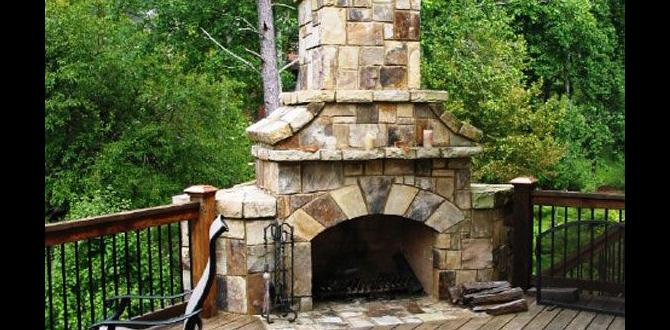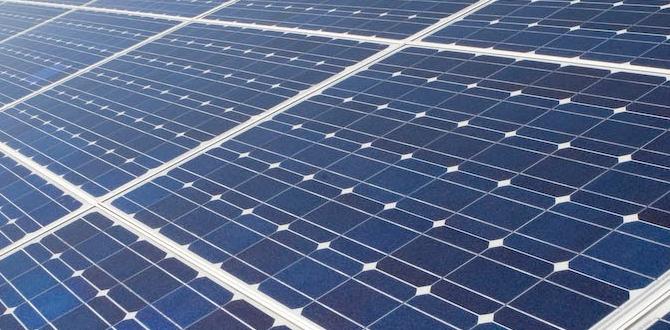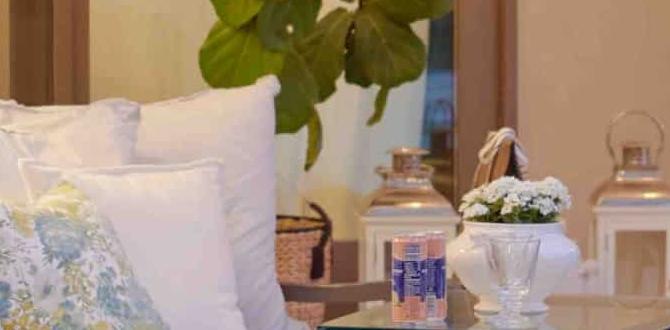Self-watering planters for indoor plants are a game-changer, providing worry-free hydration for your green companions. They ensure consistent moisture, prevent over/underwatering, and are perfect for busy plant parents or those new to the indoor jungle!
Are you tired of playing the guessing game with your indoor plants? Worrying if you’ve given them too much water or, worse, forgotten them altogether? It’s a common struggle for many plant lovers, especially when life gets busy. But what if there was a way to keep your leafy friends happy and hydrated with minimal effort?
Well, there is! Self-watering planters take the stress out of plant care. They’re like having a little watering assistant built right into the pot, delivering just the right amount of water your plant needs, when it needs it. No more soggy roots or parched soil! This guide will walk you through everything you need to know about these fantastic planters, transforming your home into a thriving green oasis without the constant fuss. Get ready to discover how easy and rewarding indoor plant care can be!
What Exactly Are Self-Watering Planters?
Self-watering planters, sometimes called reservoir planters or sub-irrigated planters, are a clever innovation designed to simplify plant care. At their core, they consist of two main parts: an outer pot or reservoir and an inner pot where your plant resides. Between these two components, there’s a water reservoir that holds a supply of water. A wicking system, often a rope, fabric strip, or a special kind of pottery, draws water up from the reservoir into the soil as the plant needs it. This continuous, controlled moisture delivery means your plant’s roots have access to water without being waterlogged, promoting healthier growth and reducing the risk of common watering mistakes.
Why You Need Self-Watering Planters for Your Indoor Jungle
Let’s dive into why these planters are such a boon for indoor plant enthusiasts, especially beginners. The benefits are numerous, making them a truly essential tool for a thriving home garden.
Key Benefits of Using Self-Watering Planters:
- Prevents Overwatering & Underwatering: This is the BIGGEST advantage. The wicking system ensures the soil stays consistently moist but not saturated, mimicking natural rainfall patterns. Your plant takes only what it needs right from the roots.
- Reduces Watering Frequency: Because there’s a water reservoir, you don’t need to water as often. This is a lifesaver for busy individuals, frequent travelers, or anyone who simply forgets to water regularly.
- Promotes Healthier Root Growth: Consistent moisture encourages roots to grow downwards in search of water, leading to a stronger, more robust root system. This is crucial for overall plant health and resilience.
- Ideal for Vacation: Going on holiday? A self-watering planter can keep your plants happy and hydrated for weeks, giving you peace of mind while you’re away.
- Water Savings: Less water is lost to evaporation from the soil surface compared to traditional top watering, making them a more eco-friendly option.
- Reduces Pest & Disease Risk: Overwatering is a common cause of root rot and fungal diseases. Self-watering planters help maintain optimal soil moisture, decreasing these risks.
- Beginner-Friendly: They remove much of the guesswork from watering, making them perfect for those new to plant care.
How Do Self-Watering Planters Actually Work?
Understanding the science behind these planters makes them even more impressive! It’s all about capillary action – a phenomenon where liquids in narrow spaces move against gravity. Here’s a simplified breakdown:
- The Reservoir: At the bottom of the planter, there’s a water storage area (the reservoir).
- The Wick: A porous material (like a cotton rope, felt strip, or porous ceramic insert) extends from the reservoir up into the soil of the inner pot.
- Capillary Action: As the soil begins to dry out, it pulls the water from the reservoir up through the wick. This process continues until the soil reaches its optimal moisture level.
- Air Gap: Most designs include an air gap between the water in the reservoir and the base of the soil, preventing the soil from becoming waterlogged and allowing the roots to breathe.
- Water Indicator (Optional): Many planters have a small indicator rod or window that shows you the water level in the reservoir, so you know exactly when to refill it.
It’s a beautifully simple, yet effective, system that ensures your plants are consistently nurtured!
Types of Self-Watering Planters
While the core principle is the same, self-watering planters come in various designs to suit different needs and aesthetics. Knowing the types can help you choose the best fit for your plants and home decor.
Common Designs to Consider:
- Wicking Systems: These are the most common. They utilize a wick (rope, fabric, or string) to draw water from the reservoir. They are versatile and work well for a wide range of plants.
- Sub-Irrigation Systems (SIPs): Often found in larger containers or raised beds, SIPs have a built-in perforated platform or a false bottom that creates a reservoir below the soil. Water is often filled through a separate tube.
- Ceramic Inserts: Some planters use unglazed ceramic cones or inserts. As the soil dries, it draws moisture from the water held within the porous ceramic.
- Double-Pot Systems: These typically involve an inner pot with drainage holes that sits inside a larger outer pot. The space between the pots acts as the reservoir, and a wick connects the soil to the water.
Materials & Aesthetics:
Self-watering planters are made from a variety of materials, including:
- Plastic: Lightweight, durable, and affordable. Available in many colors and styles.
- Ceramic: Offers a more decorative and elegant look, but can be heavier and more fragile.
- Terracotta: Some designs incorporate terracotta for its breathable and wicking properties, often used for the inner pot or reservoir component.
- Metal: Provides a modern, industrial aesthetic but can be prone to rust if not properly treated.
Choosing the Right Self-Watering Planter for Your Needs
With so many options, how do you pick the perfect planter? Consider these factors:
Factors to Guide Your Choice:
- Plant Type: Some plants prefer consistently moist soil (like ferns and peace lilies), making them excellent candidates for self-watering planters. Others, like succulents and cacti, prefer to dry out completely between waterings and might not be the best fit unless you can ensure they dry sufficiently.
- Size of the Plant: Ensure the planter size is appropriate for your plant’s current root ball and allows for some growth. The reservoir size should also be proportional to the pot size to avoid overfilling or drying out too quickly.
- Aesthetics: The planter should complement your home decor.
- Budget: Prices can vary significantly based on material, size, and brand.
- Ease of Use: Look for planters with clear water indicators and easy refilling mechanisms.
A Quick Comparison Table:
Here’s a look at some pros and cons based on common planter types:
| Planter Type | Pros | Cons | Best For |
|---|---|---|---|
| Wicking System (Rope/Fabric) | Versatile, good moisture control, affordable, easy to set up. | Wicks can degrade over time; may require occasional flushing of reservoir to prevent mineral buildup. | Many common houseplants (ferns, peace lilies, pothos, spider plants). |
| Sub-Irrigation Planters (SIPs) | Large water capacity, excellent for larger plants or those that drink a lot; great for extended periods away. | Can be bulkier and more expensive; may not be ideal for very small plants. | Larger houseplants, herbs, vegetables (if using larger outdoor SIPs). |
| Ceramic Insert/Cone | Aesthetically pleasing, natural material, good for consistent moisture. | Can be fragile; effectiveness depends on fitting within the pot; may clog if water is too mineral-rich. | Mid-sized houseplants that prefer steady moisture. |
| Double-Pot System | Simple design, often visually appealing, clear separation of soil and water. | Can be more expensive; ensure good wick contact; potential for mosquito breeding in reservoir if not properly designed/maintained. | General houseplants, especially those sensitive to root disturbance. |
Setting Up Your Self-Watering Planter: A Step-by-Step Guide
Getting your new self-watering planter ready for its plant is straightforward. Follow these simple steps to ensure success:
What You’ll Need:
- Your chosen self-watering planter
- Appropriate potting mix (important for wicking!)
- Your plant
- Water
- (Optional) Gravel or perlite for drainage layer if recommended by planter manufacturer
Step-by-Step Setup:
- Assemble the Planter: Lay out all the components of your self-watering planter. Familiarize yourself with how the inner pot, outer pot, and wicking system fit together. Most come with simple instructions.
- Prepare the Wick: If your planter uses a rope or fabric wick, it’s often a good idea to pre-soak it in water until fully saturated. This helps initiate the wicking process immediately. Thread the wick through the designated hole(s) in the inner pot, ensuring one end dangles into where the reservoir will be, and the other is positioned to go into the plant’s root ball.
- Add Potting Mix: Fill the inner pot partially with your potting mix. Make sure the soil makes good contact with the wick. For optimal performance, use a potting mix that is light and airy, as dense soils can impede wicking. A good general-purpose potting mix, sometimes with added perlite or coco coir, works well. Avoid heavy garden soil. Learn more about creating the perfect soil at the Royal Horticultural Society (RHS) for expert soil advice.
- Position Your Plant: Gently remove your plant from its nursery pot. Loosen any tightly bound roots. Place the plant in the inner pot, centering it.
- Fill Around the Plant: Add more potting mix around the plant’s root ball, ensuring the soil is firm enough to hold the plant upright and that the wick is well-embedded within the soil reaching the roots. Do not pack the soil too tightly, as this can prevent air circulation and proper wicking.
- Initial Top Watering: Water the plant thoroughly from the top the very first time. This helps settle the soil around the roots, ensures excellent contact between the soil and the wick, and flushes out any excess salts from the potting mix. Let any excess water drain through.
- Fill the Reservoir: Once the initial watering has drained, fill the water reservoir according to the planter’s instructions. This is usually done through a specific filling tube or by slightly lifting the inner pot. Be careful not to overfill, as this can drown the lower roots.
- Monitor: Place your assembled planter in its desired location. For the first week or two, keep an eye on the soil moisture and the water level in the reservoir. This helps you understand your plant’s water usage and how the self-watering system is performing.
Maintaining Your Self-Watering Planters
While self-watering planters significantly reduce maintenance, a little upkeep ensures they function optimally and your plants stay healthy long-term.
Regular Checks and Care:
- Refill the Reservoir: Keep an eye on the water indicator. Refill the reservoir when it’s low, but avoid overfilling. It’s generally better to let the reservoir run nearly dry occasionally for some plants to allow the root zone to get a brief period of aeration.
- Flush the System Periodically: Every few months (or at least twice a year), it’s a good idea to flush the system. Water the plant thoroughly from the top, letting water run through the planter and drain out completely. This helps prevent the buildup of mineral salts in the soil, which can occur from fertilizers and tap water, and can harm your plants.
- Inspect the Wick: Over time, wicks can degrade, especially organic materials like cotton. Check the wick periodically for signs of wear and tear. If it looks frayed or is no longer effectively drawing water, it may need replacing. Many manufacturers offer replacement wicks.
- Clean the Reservoir: When repotting or changing the soil (typically every 1-2 years), clean out the water reservoir. This removes any accumulated sediment or algae, ensuring the water stays clean.
- Monitor Soil Health: While self-watering systems are great, periodically check the soil for any signs of compaction, mold, or unpleasant odors. If you notice issues, it might be time to repot with fresh soil or adjust your watering habits slightly.
- Fertilizing: Plants in self-watering planters still need nutrients. You can add liquid fertilizer to the water reservoir, but it’s best to do this sparingly and dilute it more than usual, as the consistent moisture can lead to over-fertilization if not careful. Alternatively, you can use slow-release fertilizers mixed into the potting soil during repotting.
For detailed information on fertilizer types and application, the Oregon State University Extension offers excellent resources.
Troubleshooting Common Issues
Even with the best systems, you might encounter a hiccup. Here are some common problems and their solutions:
Problem: Soil Stays Too Wet
- Cause: Potting mix is too dense; wick is too thick; reservoir is too large; plant doesn’t drink much water.
- Solution: Use a lighter, airier potting mix with perlite or coco coir. Check if the wick is fully saturated and drawing too much water. Ensure the reservoir isn’t constantly overflowing. For plants that don’t need constant moisture, consider letting the reservoir dry out completely between fillings. Trim the wick or use a thinner one.
Problem: Soil Stays Too Dry
- Solution: Ensure the wick is making good contact with both the water in the reservoir and the soil. Check if the wick is old or degraded and needs replacing. Make sure the reservoir is filled correctly. If using a very porous potting mix, it might be drying out too quickly; mix in some moisture-retaining elements like coco coir.
Problem: Algae or Mold Growth in Reservoir or on Soil Surface
- Cause: Exposed water, overfilling, lack of airflow.
- Solution: Clean the reservoir thoroughly. Ensure the planter design prevents light from reaching the water. Avoid overfilling. If mold appears on the soil surface, gently scrape it off and improve air circulation around the plant. Flushing the system can help.
Problem: Mineral Buildup (White Crust on Soil/Planter)
- Cause: Accumulation of salts from water and fertilizer.
- Solution: Periodically flush the system by watering thoroughly from the top and letting excess water drain. Use filtered or distilled water if your tap water is particularly hard. Reduce fertilizer concentrations.
Best Plants for Self-Watering Planters
Not all plants thrive equally in self-watering planters. Those that enjoy consistent moisture are typically the happiest. Here are some top choices:
Great Plants for These Planters:
- Peace Lily (Spathiphyllum): Famous for wilting dramatically when thirsty, they adore consistent moisture.
- Ferns (e.g., Boston Fern, Maidenhair Fern): These humidity-loving plants need consistently moist soil.
- Spider Plant (Chlorophytum comosum): Tolerant and adaptable, they do well with steady hydration.
- Pothos (Epipremnum aureum): Easy-care vines that appreciate consistent moisture and forgive occasional neglect.
- Chinese Evergreen (Aglaonema): These attractive foliage plants prefer to stay consistently moist.
- African Violets (Saintpaulia): They have sensitive roots that benefit from bottom watering, which self-watering planters mimic perfectly.
- Herbs (Basil, Mint, Parsley): Many common culinary herbs love consistent moisture, making them ideal for kitchen windowsill gardens.
For moisture-sensitive plants like succulents, cacti, or orchids, self-watering planters might require careful monitoring to ensure the soil dries out sufficiently, or they may be better suited to traditional pots.
Eco-Friendly Aspects of Self-Watering Planters
As an eco-living enthusiast,



